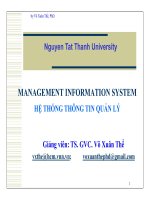Management information system ralp 7e ch01
Bạn đang xem bản rút gọn của tài liệu. Xem và tải ngay bản đầy đủ của tài liệu tại đây (1.24 MB, 50 trang )
• The value of information is directly linked to how it helps
decision makers achieve the organization’s goals
• Discuss why it is important to study and understand
information systems
• Distinguish data from information and describe the
characteristics used to evaluate the quality of data
Principles of Information Systems, Seventh Edition
2
• Models, computers, and information systems are
constantly making it possible for organizations to
improve the way they conduct business
• Name the components of an information system and
describe several system characteristics
• Identify the basic types of models and explain how they are
used
Principles of Information Systems, Seventh Edition
3
• Knowing the potential impact of information systems and
having the ability to put this knowledge to work can result in
a successful personal career, organizations that reach their
goals, and a society with a higher quality of life
• List the components of a computer-based information system
• Identify the basic types of business information systems and
discuss who uses them, how they are used, and what kinds of
benefits they deliver
Principles of Information Systems, Seventh Edition
4
• System users, business managers, and information
systems professionals must work together to build a
successful information system
• Identify the major steps of the systems development
process and state the goal of each
Principles of Information Systems, Seventh Edition
5
• Information systems must be applied thoughtfully and
carefully so that society, business, and industry can reap
their enormous benefits
• Describe some of the threats to security and privacy that
information systems and the Internet can pose
• Discuss the expanding role and benefits of information
systems in business and industry
Principles of Information Systems, Seventh Edition
6
Introduction
• Information system (IS)
• A set of interrelated components that collect, manipulate,
and disseminate data and information and provide feedback
to meet an objective
• Examples: ATMs, airline reservation systems, course
reservation systems
Principles of Information Systems, Seventh Edition
7
Information Concepts:
Data Versus Information
• Data: raw facts
• Information: collection of facts organized in such a
way that they have additional value beyond the facts
themselves
Principles of Information Systems, Seventh Edition
8
Table 1.1: Types of Data
Principles of Information Systems, Seventh Edition
9
Figure 1.1: Defining and Organizing
Relationships Among Data Creates Information
Principles of Information Systems, Seventh Edition
10
Figure 1.2: The Process of
Transforming Data into Information
Principles of Information Systems, Seventh Edition
11
Table 1.2: Characteristics of Valuable Data
Principles of Information Systems, Seventh Edition
12
Table 1.2: Characteristics of Valuable
Data (continued)
Principles of Information Systems, Seventh Edition
13
System and Modeling Concepts
• System: a set of elements or components that interact to
accomplish goals
• Components of a system
• Input
• Processing
• Output
• Feedback
Principles of Information Systems, Seventh Edition
14
Figure 1.3: Components of a System
Principles of Information Systems, Seventh Edition
15
System Components and Concepts
• System boundary: defines the system and distinguishes
it from everything else (i.e., the environment)
• Configuration: the way system elements are organized
or arranged
• Systems can be classified as simple or complex, open or
closed, stable or dynamic, adaptive or nonadaptive, and
permanent or temporary
Principles of Information Systems, Seventh Edition
16
Table 1.3: Systems Classifications and
Their Primary Characteristics
Principles of Information Systems, Seventh Edition
17
System Performance and Standards
• Efficiency: a measure of what is produced divided by
what is consumed
• Effectiveness: extent to which system attains its goals
• System performance standard: a specific objective of a
system
Principles of Information Systems, Seventh Edition
18
System Variables and Parameters
• System variable: quantity or item controlled by the
decision maker
• System parameter: value or quantity that cannot be
controlled (e.g., the cost of a raw material)
Principles of Information Systems, Seventh Edition
19
Modeling a System
• Model: an abstraction that is used to represent reality
• Four major types of models: narrative (based on words);
physical (tangible); schematic (graphic representation);
mathematical (arithmetic representation)
Principles of Information Systems, Seventh Edition
20
Figure 1.6: Four Types of Models
Principles of Information Systems, Seventh Edition
21
Figure 1.7: The Components of an
Information System
Principles of Information Systems, Seventh Edition
22
Input, Processing, Output, Feedback
• Input: activity of gathering and capturing raw data
• Processing: converting or transforming data into useful
outputs
• Output: production of useful information, usually in
form of documents and reports
• Feedback: output used to make changes to input or
processing activities
Principles of Information Systems, Seventh Edition
23
Computer-Based Information Systems
• Computer-based information system (CBIS)
• A single set of hardware, software, databases,
telecommunications, people, and procedures that are
configured to collect, manipulate, store, and process data
into information
• Examples: a company’s payroll systems, order entry
system, and inventory control systems
Principles of Information Systems, Seventh Edition
24
Figure 1.8: The Components of a
Computer-Based Information System
Principles of Information Systems, Seventh Edition
25









